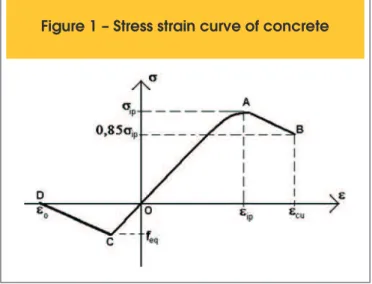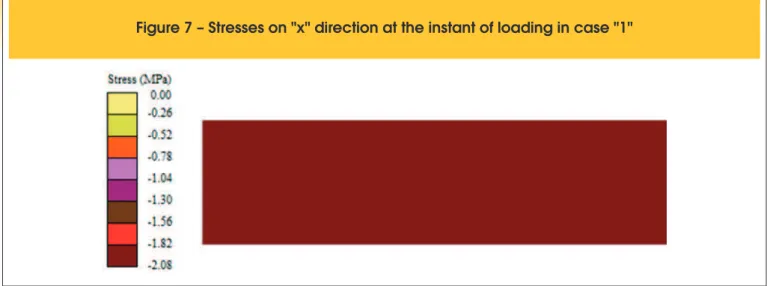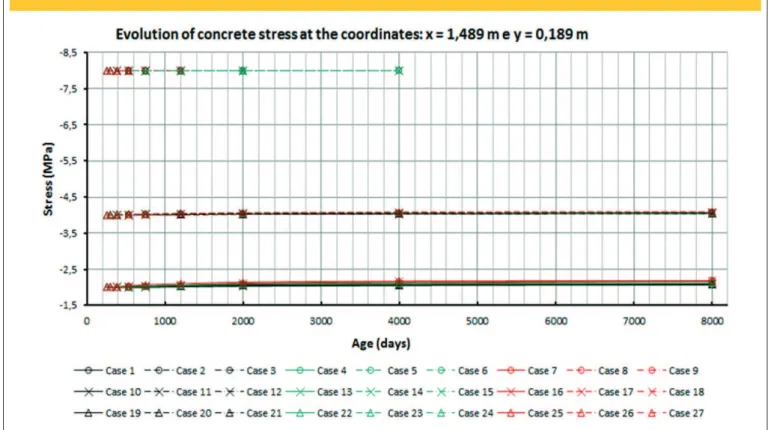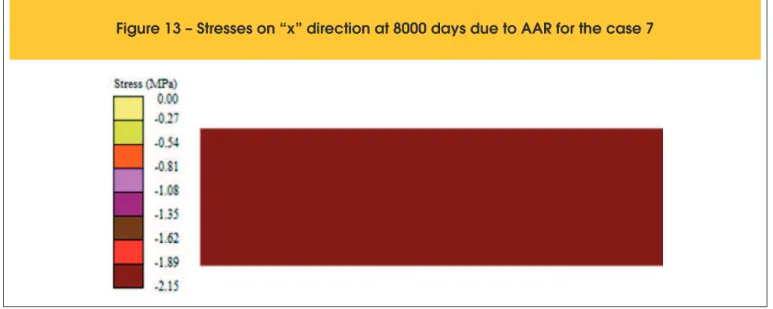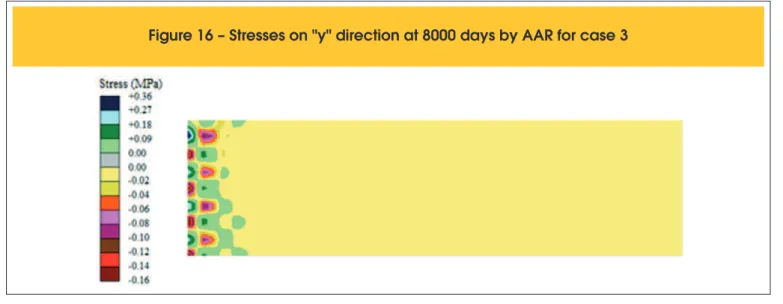Parametric analysis of AAR inluent factors
on thin-walled columns
Análise paramétrica dos fatores inluentes da RAA
em pilares parede
Abstract
Resumo
The chemical reaction involving the alkalis of the cement and some minerals of the concrete aggregates, the Alkali-Aggregate Reaction or, simply,
the AAR, promotes swelling and material damages. Despite the development stage of the researches on this pathology efects, its solution model
-ing still lacks reinement. The numerical simulation is an important resource for the structural damages evaluation due to AAR, and their repairs. The aim of this work is the numerical simulation of concrete thin-walled columns, afected by the AAR, from the inite element approximation on an
orthotropic nonlinear framework, and a thermodynamic model designed to the assessment of the AAR swelling, with highlight on the compressive
stress, the reinforcement and the temperature inluences on the phenomenon. The obtained results revealed that the AAR induced the concrete strength decrease and the consequent reduction in preventive safety margin to the material failure, being more precocious at higher temperatures. Keywords: simulation, alkali-aggregate reaction, column, temperature.
A reação química que envolve os álcalis do cimento e alguns minerais dos agregados de concreto, a reação álcali-agregado ou, simplesmente, a RAA, promove danos materiais e expansão. Apesar do avanço das pesquisas sobre os efeitos desta patologia, a modelagem de sua solução ainda carece de reinamento. A simulação numérica é um recurso importante para a avaliação de danos estruturais devido a RAA e os seus reparos. O objetivo deste trabalho é a simulação numérica de pilares parede de concreto, afetados pela RAA, A partir da aproximação por ele-mentos initos sobre um esquema de cálculo ortotrópic não-linear e um modelo termodinâmico, voltado para a avaliação das expansões por RAA, destacando a inluência da tensão de compressão, da armadura e da sobre o fenômeno. Os resultados obtidos revelaram que a RAA induziu a diminuição da resistência do concreto e a consequente redução da margem de segurança prévia à ruína do material, sendo mais precoce para temperaturas mais elevadas.
Palavras-chave: simulação, reação álcali-agregado, pilar, temperatura.
E. L. MADUREIRA a
edmadurei@yahoo.com.br E. C. RODRIGUES a
1. Introduction
The Alkali-Aggregate Reaction, or simply the AAR, is a chemi-cal transformation involving the alkalis from Portland cement and
some minerals from concrete aggregates [16], and aroused inter
-est in the Civil Engineering scope when it was observed some damages in concrete structures afected by its deleterious action. The pathology includes cracking that can culminate in widespread ruin and impairment of serviceability.
Despite the availability of experimental results, the formulation of the problem still lacks reinement, so that the efectiveness of your solution remains doubtful. The numerical simulation represents a suitable tool for the quantiication of the damages caused by the AAR, may assist the structural recovery tasks and serve as a basis for design criteria formulation.
The most of the models so far developed adopts linear constitutive relations, despite the nonlinear concrete behavior, and the AAR random and its anisotropic nature.
The aim of this work is the numerical simulation of the mechanical performance of reinforced concrete thin-walled columns, afected by the swelling due to the AAR, emphasizing the compressive stress magnitude, the steel reinforcement ratio and the tempera
-ture level inluences on the phenomenon.
In order to achieve such purpose it was used a computational sup
-port that was developed on the basis of the inite element method on an orthotropic framework and nonlinear constitutive relation -ships for concrete, in addition to a thermodynamic model for the
assessment of the deformations due to AAR.
2. Modeling
2.1 Concrete response to loading
The numerical analysis was performed on an incremental iterative procedure and inite element approach adopting the orthotropic nonlinear formulation proposed by KWAK and FILIPPOU [9], from which the constitutive matrix is deined through the equivalent
strains “eei”, that are given by:
(1)
ii j ij i
ei
e
D
e
/
D
e
=
+
The “i” and “j” indexes refer to principal plane direction. The “Dij”
parameters represent the constitutive matrix elements.
For the simulation of concrete in compression it was adopted the constitutive relationships proposed by HOGNESTAD [7] whose hardening branch, OA segment of the curve illustrated in igure 1, is represented by the form:
(2)
ei ip ei
ip ip
i
1
2
.
.
.
2
e
e
e
e
s
s
÷
÷
ø
ö
ç
ç
è
æ
-=
for
e
ip<
e
ei< 0;
The parameters “sip” and “eip” represent the concrete peak stress
and its correspondent strain beyond every “i” principal direction.
The adopted concrete deformation module is the secant modulus
“EC” that is obtained according to [1].
The concrete ultimate stresses are deined from the failure enve
-lope proposed by KUPFER and GERSTLE [8], igure 2, whose analytical representation in biaxial compression state is:
(3)
0
65
.
3
)
(
2 2 12
1
+
b
-
b
-
b
=
b
where,
β
1=
s
1/
f
c andβ
2=
s
2/
f
c, and s1 and s2, s2 < s1 < 0, arethe principal stresses. “
f
c” is the concrete uniaxial compressivestrength. If
α
=
s
1/
s
2 in equation 3, the concrete peak stresses,Figure 1 – Stress strain curve of concrete
on the principal directions, would be given by:
(4)
c
c
2
f
2
)
1
(
.
65
.
3
1
a
a
s
+
+
=
and
s
1c=
s
cu=
a
.
s
2cThe strains related to peak stresses in biaxial compression state, “e2p” and “e1p”, according to [9], would be obtained from the expressions:
(5)
(
3
22
)
co p
2
=
e
b
-e
and
1 2 1 3 1 co p
1
e
1
.
6
b
2
.
25
b
0
.
35
b
e
=
-
+
+
where c p 1 1
f
s
β
=
andc p 2 2
f
s
β
=
. The parameter “eco” is the straincorresponding to the compressive peak stress in uniaxial state
of stress.
For concrete subjected to biaxial state of stresses, it was adopt
-ed the constitutive relationship on incremental form propos-ed by DESAI and SIRIWARDANCE [5], according the equation:
(6)
.
).G
-(1
0
0
0
E
.
E
0
E
1
1
12
2
1
2
2
2
1
2
1
1
2
12
2
1
g
e
e
n
n
n
n
t
s
s
d
d
d
E
E
E
d
d
d
-=
The “dσ1”, “dσ2” e “dτ12” parameters presented on equation 6 are
the stress increments on the principal directions. The “Ei’s”
param-eters are the tangent deformation modules relating to such direc
-tions and “ν” is the Poisson’s ratio. The “G” parameter is the trans
-versal deformation module that is given by:
(7)
(
1 2 1 2)
2).
G
0
.
25
E
E
2
E
.
E
1
(
-
n
=
+
-
n
In this analysis were adopted the quadratic approximation isopara
-metric inite elements.
The solid mass of concrete region is represented by the plane eight-node quadrilateral elements Q8, as shown in igure 3.a.
2.2 Steel response to loading
The steel behaviour is considered as been elastic perfectly plastic and the reinforcement steel bars are simulated by bar three-node elements L3, igure 3.b. In this way, the stifness matrix “K” is expressed by:
(8)
ú
ú
ú
û
ù
ê
ê
ê
ë
é
=
2
1
1
-1
1
0
1
0
1
L
AE
2
K
The parameter “E” is the steel Young’s modulus, “A” is the rein
-forcement bar elements cross sectional area and “L” is the bar i -nite element length.
2.3 Alkali-aggregate reation swelling efect
For the swelling over time simulation it was adopted the thermo
-dynamic formulation proposed by CAPRA and SELLIER [3] that correlates the deformations by AAR to the kinetic of the reaction
in the form:
(9)
0
o
o
o
RAA
o
RAA
A
A
for
)
A
A
(
A
A
A
for
0
>
-=
<
»
e
e
e
where the “A” parameter is the reacted alkalis content over time; “Ao” is the “A” value corresponding to the beginning of the concrete
matrix swelling by AAR, and, “eo” is the deformation parcel to be subtracted from the total value, with the aim to consider the time gap between the beginning of the reaction and the instant in which the concrete matrix expansion is triggered, as shown in Figure 4. For the reaction kinetic modeling, CAPRA and BOURNAZEL [2], has proposed the equation:
(10)
)
1
)(
(
T
A
k
dt
dA
=
-for which “k (T)” is the kinetic constant associated to the Arhenius law, that is evaluated from:
(11)
RT E o ae
k
T
k
(
)
=
-Figure 3 – Finite Elements: a) Bars L3;
b) Planes Q8
where “Ea” is the reaction activation energy, “R” is the ideal gas
constant, “T” is the temperature and “ko” is the basic kinetic con -stant. The solution for equation 10 is:
(12)
kt
o
e
A
A
=
1
-
(
1
-
)
-Resulting for Equation 9, in the range at A > Ao, the relationship:
(13)
)
1
)(
1
(
)
,
(
(ke / )to o
o
RAA Ea RT
o
e
A
A
T
t
=
e
-
-
--e
The conining stress inluence was considered from the criterion proposed by CHARLWOOD [4], expressed in the form:
(14)
u
g
L
i
s
e
e
s
£
®
=
£
0
÷
ø
ö
ç
è
æ
-=
®
£
£
L i u g iL
s
s
e
e
K
s
s
s
max.
log
10where “si” is the principal stress in the “i” direction, expressed in MPa, “eg” is the conined deformation, “eu” is the unconined defor -mation. “sL “, whose value may be ixed approximately equal to
0.3 MPa, is the stress below which the expansion may be consid
-ered as unconined one. The parameter “smax”, whose magnitude is closed to 8.0 MPa, is the stress at which the AAR deformation may be considered null, and the “K” constant is the slope of the
straight line e x logs.
The moisture content inluence on the phenomenon is expressed through the curve proposed by POOLE [14], expressed on the form of the equation 15.
(15)
m
H
H
F
(
)
=
where “m” is an adjustment parameter that must be considered as equal to 8. “H” is the moisture content value.
To express the degradation of concrete by AAR, was adopted a framework similar to that proposed by PIETRUSZCZAC [12], that was adapted by RODRIGUES [15] to the deformation by AAR progress according CAPRA and SELLIER [3], that resulted
on the relationships:
(16)
ú
û
ù
ê
ë
é
-=
--)
e
A
1
1
1
)(
A
1
(
1
E
E
(ke t)o E o RT / a E o
(17)
ú
û
ù
ê
ë
é
-=
e
- -)
A
1
1
1
)(
A
1
(
1
f
f
(ke t)o f co c RT / a E o
for which “E” and “Eo” are the inal and initial deformation mod
-ules, respectively, and, similarly, “fc” and “fco” refer to the
com-pressive strength. The parameters “AE” and “Af” represent the
concrete deformation modulus and compressive strength deg -radation intensity factors, respectively.
The concrete failure possibility analysis was performed taking into reference the Normalized Stress that was deined as the ratio between the stress magnitude on the concrete solid mass and its strength values at the considered instant of time. So that, the Normalized Stress represents a dimensionless parameter whose value is little than the unit and reach such limit values in those cases in which the failure is imminent.
Figure 4 – Schematic chart for definition
of the parameters “
e
o” and “A ”
oTable 1 – Program validation: displacements
by AAR
Displacements ( 10-3 mm )
Time ( Days ) Theoretical model
Numerical model
Difference (%)
75 5.27 5.24 0.6
150 9.90 9.80 1.0
300 17.40 17.30 0.6
600 28.30 28.10 0.7
1200 41.20 40.90 0.7
2500 54.00 53.60 0.7
5000 62.90 62.50 0.6
3. Computational support
In this work it was applied the software non-Linear Constitutive Analy
-sis-ACNL, based on the inite element method (FEM) and written in the FORTRAN codiication as described in [10]. The computational code includes in its algorithmic framework the formulations of the bar and the plane elements, both isoparametrics, on a quadratic approximation. The displacement ields were plotted from the graphic post-proces
-sor named NLPOS developed by PITANGUEIRA and PARENTE Jr [13], while the stress ields were drawn up from the graphic post-processor PROJECT1 developed by MADUREIRA and SILVA [11].
4. Computational program validation
For its validation purpose, the program was used to analyze, in a plane state of stresses, a concrete thin-walled column, 3.00 m length and rectangular cross-section 0.20 m width and 1.00 m height, reinforced by eight 10 mm diameter bars. The structural
member is subjected to an axial load of 800 kN. The results of such analysis were compared with their corresponding values, ob
-tained by calculations that were carried out from a simpliied mod
-el, drawn up on the basis of the Solid Mechanic Postulates, in the uniaxial state of stresses, as performed by RODRIGUES [15]. The obtained results presented good agreement as shown in Table 1.
5. Analysed specimens
The analysis was carried out considering as studying subject a thin-walled column constituted by concrete C20 reinforced by CA-50 steel bars. The concrete Poisson’s ratio and its deformation module value were ixed at 0.17 and 21300 MPa, respectively. The steel Young modulus and the steel yielding stress were ixed, re -spectively, at 210000 MPa and 500 MPa.
For the reaction activation energy was adopted the value of 8500 m³.Pa. mol-1, proposed by GHANEM et al. [6]. And, for the Avogadro’s number, it was used the conventional value 6.02214129 x 1023 mol-1.
Figure 5 – Problem domain and finite element mesh
For the concrete modulus of deformation and the compressive strength degradation intensity factors, were adopted the values AE = 0.3 and Af = 0.4, respectively, that was based on the experimen
-tal results obtained by SWAMY and AL-ASALI [17].
The studied columns are 3.00 m height and presents rectangular cross-section 1.60 m width and 0.20 m thick, and was submitted,
Figure 7 – Stresses on "x" direction at the instant of loading in case "1"
Table 2 – Studied models and displacements
Case T (°C) As (cm²) σ (MPa) Displacement
Loading AAR
1 20 12.80 2.0 0,30 -0,27
2 20 12.80 4.0 0,61 -0,14
3 20 12.80 8.0 1,30 0,00
4 20 20.00 2.0 0,30 -0,27
5 20 20.00 4.0 0,61 -0,13
6 20 20.00 8.0 1,30 0,00
7 20 32.00 2.0 0,30 -0,26
8 20 32.00 4.0 0,61 -0,13
9 20 32.00 8.0 1,30 0,00
10 50 12.80 2.0 0,30 -0,28
11 50 12.80 4.0 0,61 -0,14
12 50 12.80 8.0 1,30 0,00
13 50 20.00 2.0 0,30 -0,27
14 50 20.00 4.0 0,61 -0,13
15 50 20.00 8.0 1,30 0,00
16 50 32.00 2.0 0,30 -0,26
17 50 32.00 4.0 0,61 -0,13
18 50 32.00 8.0 1,30 0,00
19 100 12.80 2.0 0,30 -0,27
20 100 12.80 4.0 0,61 -0,14
21 100 12.80 8.0 1,30 0,00
22 100 20.00 2.0 0,30 -0,27
23 100 20.00 4.0 0,61 -0,13
24 100 20.00 8.0 1,30 0,00
25 100 32.00 2.0 0,30 -0,26
26 100 32.00 4.0 0,61 -0,13
after 28 days, computed from the concrete casting date, to a uni
-formly distributed load along its top cross section area, Figure 5. For the purposes of the structural member graphic representation it was promoted a 90o rotation on its longitudinal axis, which was drawn on this fashion in order to coincide with the horizontal direc
-tion in the page plane (direc-tion “x”). Taking advantage of the its symmetry, the problem mathmatical domain at the “xy” plane was deined as shown in Figure 5.
For the plane inite elements was adopted the square shape and for the problem domain discretization was considered that both types of inite element are 0.10 m length, resulting for the inite ele
-ment mesh 240 plane ele-ments and 120 bar ele-ments, Figure 5.
Figure 8 – Displacement on "x" direction due to AAR
The analysis was performed over twenty-seven cases, diferenti
-ated among themselves by the concrete solid mass temperature, by the steel bar reinforcement cross-sectional area and by the compressive stress magnitude, as shown in table 2.
6. Results and discussions
The obtained results showed that, for the “1”, “4”, “7”, “10”, “13”, “16”, “19”, “22” and “25” cases, for which the compressive stress in the column longitudinal axis direction is the order of 2.0 MPa, the displacements and the stresses ields at the instant of loading pre
-sented themselves as shown in igures 6 and 7, respectively. The
structural member shortening was by 0.3 mm, approximately. For the cases concerning to the stress magnitude by 4.0 and 8.0 MPa, that shortening was by 0.6 mm and 1.3 mm, respectively, table 2. Once the AAR swelling efect on concrete solid mass was trig
-gered, the columns stretched themselves progressively as shown on the curves of Figure 8. It may be identiied in that picture three distinct bundles of lines, pointing out that, for compression stress
-es of l-esser magnitude, the expansions by AAR assumed larger values. It also may be noted that, for the “1”, “4”, “7”, “10”, “13”, “16”, “19”, “22” and “25” cases, the AAR swelling was already sta
-bilized after 8000 days from its beginning, and the corresponding displacement ield exhibited the aspect shown in Figure 9. The inal stretches were closed to 0.27 mm, representing 90% of the con
-traction value occurred at the instant of loading, table 2. For the “2”, “5”, “8”, “11”, “14”, “17”, “20”, “23” and “26” cases, corresponding to the stress magnitude of 4.0 MPa, the column response was similar, nevertheless, the stretching was about 0.13 mm, table 2, reaching thus 21% of the contraction at the instant of loading. For the other cases, which are referred to the stress magnitude of 8.0 MPa, the expansions due to AAR swelling were, virtually, null, as expected from the problem modeling criterion.
It was also noted that, for the “1”, “2”, “4”, “5”, “7” and “8” cases,
referring to the 20oC temperature, the expansions by AAR solely began and one stabilized at 510 and 8000 days, respectively, from the AAR beginning. For “10”, “11”, “13”, “14”, “16” and “17” cases, in turn, related to the 50oC temperature, such a dates were 370 and 6000 days, and, for “19”, “20”, “22”, “23”, “25” and “26” cases, con
-cerning to the 100oC temperature, they were 240 and 4000 days, Figure 8 and Figure 10.
One may be observed that the columns referring to “2”, “5”, “8”, “11”, “14”, “17”, “20”, “23” and “26” cases, whose stress magnitude is of 4.0 MPa, presented inal displacements due to AAR, virtu
-ally, identical. Such a response, speci-ally, for the “2”, “11”, and “20” cases, diferentiated among themselves, solely, by the tempera
-ture, were to be expected because that parameter doesn’t afect the AAR inal swelling magnitude. The temperature catalytic efect is restricted to the reaction kinetic exerting, exclusively, the accel
-erator efect on the concrete matrix expansions. On the other hand, for those columns of this set, whose reinforcement is diferent from case to case, such king of response stays on apparent contradic
-tion in terms to the expected results because, for the greatest rein
-forcement ratio the corresponding displacement would be smaller, due to the steel bars restraint efect. Nevertheless, for these cases, it must consider that, as higher the reinforcement ratio as higher will be its capacity to absorb forces and, therefore, to make de -crease the stress on the concrete solid mass, promoting, in this
way, higher AAR deformations. Thus, the greatest deformations by AAR associated to the lowest compressive stress magnitude, may have compensated the steel reinforcement restraint efect that, certainly, would result on smaller stretching. Such explanation is valid, included, for those cases in which the stress magnitude was
of 2.0 MPa.
It may also be note that, during the AAR swellings, the normal
tude variations, Figure 11. One may attribute this kind of response to the fact that the deformations by AAR have been little signiicant. For the cases referring to the higher reinforcement ratio, as the case 7, the stress ields at the instant of loading presented discrete disturbing in the immediate vicinity of the load application surface that was attenuated by the deformation reversal trend due to AAR expansions, as shown in igures 12 and 13.
For the aims of this work it was introduced a parameter named
Normalized Compressive Stress deined as the ratio between the normal stress magnitude and the stress value corresponding to the concrete failure.
The deleterious efect of the AAR was obvious because, despite its expansions had promoted little variations in the concrete sol
-id mass stresses ields, it made decrease the concrete strength, inducing remarkable variations in the Normalized Compressive Stress, Figure 14. For the “1”, “4”, “7”, “10”, “13”, “16”, “19”, “22”
Figure 11 – Stresses on the concrete solid mass on the “x” dir ection during the AAR swelling
and “25” cases, the increase was discreet, remaining a substan
-tial safety margin at 8000 days, computed from AAR initiation. On the other hand, for the “2”, “5”, “8”, “11”, “14”, “17”, “20”, “23” and “26” cases, it was noted an increase from 0.20 to 0.67, at that age, remaining a safety margin of 33%. For the “3”, “12” and “21” cases, for which the compressive stress was about 8.0 MPa and
for the smallest reinforcement steel ratio, the increase in
Normal-ized Compressive Stress was from 0.40 to 1.0, indicating a high probability of concrete failure condition by crushing, at 1600, 2500 and 3600 days, respectively, after the AAR swelling has triggered. It may note that, in the cases for which was prescribed the higher temperatures and, therefore, the AAR swelling triggered in young
-er ages of concrete, the structural memb-er failure was anticipated. Such reality induces the need to set up diferent schedules for
corrective interventions, aimed at preserving the satisfactory
me-chanical performance of the structural member, and even reduce
the legal prediction of its lifetime.
In a general way the stresses on the concrete solid mass at the
“y” direction remained stable presenting magnitudes far below its tensile strength, as shown by the ields of igures 15 and 16. For the columns referring to “8”, “17” and “26” cases, especially, that presents the greatest steel bars reinforcement ratio, it occurred Tensile Normalized Stress increase, at a point localized into the loading introduction region at the cross-section gravity center vicin
-ity. Such an increase hit, after 8000 days, referred to the AAR initia
-tion age, a value about 0.83. The “6”, “15” and “24” cases, and, the “9”, “18” and “27” cases, corresponding to the stress magnitude equal to 8.0 MPa, presented Tensile Normalized Stress of 0.4 and 0.7, respectively, at the concrete AAR swelling beginning. Such a parameter has assumed value equal to 1.0, establishing great probability condition of failure, after a period since 500 days until 3100 days, Figure 17. It is observed that, as higher the reinforce
-ment ratio and the concrete solid mass temperature, the material failure was triggered more early, Figure 17. Nevertheless, the fact
Figure 15
–
Stresses on “y” dir ection "y" at the instant of loading for case 3
Figure 16 – Stresses on "y" direction at 8000 days by AAR for case 3
that, such stresses have been greatest for higher reinforcement ratios drops the association of such an occurrence to the cracking efort reported by MADUREIRA [10].
7. Conclusions
This work refers to AAR swelling efect analysis in reinforced con
-crete thin-walled columns, on the basis of a thermodynamic model, from a non-linear orthotropic framework and the inite element ap
-proximation.
The analysis subject of this work was carried out to evaluate the reinforcement ratio, the compressive stress and the temperature inluences on the AAR swelling efects.
For the aims of this work it was introduced a parameter named Normalized Compressive Stress deined as the ratio between the normal stress magnitude and the stress value corresponding to the concrete failure.
The obtained results showed that, for the analyzed cases, the ex
-pansions had already been stabilized at 8000 days after the swell
Such a results revealed that the column stretching induced by the AAR was as smaller as higher the compressive stress magnitude and that the swellings were virtually null for the stress magnitude about 8.0 MPa, conirming the stress coninement efect on the AAR expansions.
The AAR deleterious efect on the concrete solid mass was ob
-vious that’s why such chemical reaction promoted the structural member mechanical performance impoverishment, specially, the concrete strength reduction. Such an efect was remarkable be
-cause, for the cases corresponding to greatest compressive stress magnitude, although the variability of such kind of stress was neg
-ligible, the Normalized Compressive Stress hit values equal to the unit, featuring a condition of imminent failure.
For the cases referring to the higher reinforcement ratio, the stress ields at the instant of loading presented discrete disturbing in the immediate vicinity of the load application surface that was attenu
-ated by the deformation reversal trend due the AAR expansions. The results corroborated that the temperature exerts, exclusively, the accelerator efect on the concrete matrix expansions, because, although, for higher temperatures, the swelling efect had been trig
-gered and stabilized at earlier ages of concrete, it did not inluence the inal AAR displacement magnitude. Nevertheless, one must consider this efect relevant that’s why, for the higher temperatures, the structural member failure was anticipated inducing the needing for set up diferent elapsing time for corrective interventions, aimed to preserving the satisfactory mechanical performance of the struc
-tural member, and even to reduce the legal prediction of its lifetime.
In addition, although a higher reinforcement ratio must exert a higher AAR deformation restraint efect, on the other hand, be
-cause the steel bars supplementary capacity to absorb forces, the compression stress magnitude on the concrete solid mass would be smaller, thus contributing to higher AAR deformation. One may considered that these efects were mutually compensated that’s why the AAR deformation magnitude held, virtually, constant. Such a trend is a probable indication that the adoption of passive rein
-forcement on concrete confers low efectiveness to the AAR swell
-ing efect attenuation.
For some of the cases referring to the greatest steel bars reinforce
-ment ratio it was developed Tensile Normalized Stress increase at “y” direction by AAR that culminated into a great probability condition of failure. Nevertheless, considering that such an efect have been more pronounced for higher reinforcement ratios, its association to the cracking efort reported by MADUREIRA [10] must be discarded. To diagnose the actual consequences of this fact, on the overall per
-formance of the structural member, it would be necessary to analyze
the cracking propagation over time in a detailed fashion.
8. Acknowledgements
REUNI, and, by the Pró-Reitoria de Pesquisa da Universidade Federal do Rio Grande do Norte – UFRN. Their support is grate
-fully acknowledged.
9. References
[1] ASSOCIAÇÃO BRASILEIRA DE NORMAS TÉCNICAS.
NBR 6118: Projeto de Estruturas de Concreto - Procedimen
-to. Rio de Janeiro: ABNT, 2014.
[2] CAPRA, B. e BOURNAZEL, J. P. Modeling of Induced Me
-chanical efects of Alkali-Aggregate Reactions. Cement and Concrete Research, Vol. 28, N.2, pp. 251-260. 1998. [3] CAPRA, B. e SELLIER, A. Ortotropic Modelling of Alkali-Ag
-gregate Reaction in Concrete Structures: Numerical Simula
-tions. Mechanics of Materials, Vol 35, pp. 817-830, 2002.. [4] CHARLWOOD, R.G. A Review of Alkali-aggregate Reaction
in Hydro-electric Plants and Dams. Hydropower Dams, n 1, pp. 73-80. 1994.
[5] DESAI, C.S. e SIRIWARDANCE, H.J. Constitutive Laws for Engineering Material. Prentice-Hall, New Jersey, 1972.
[6] GHANEM, H., ZOLLINGER, D. e LYTTON, R Predicting ASR
aggregate reactivity in terms of its activation energy.
Con-struction and Building Materials, Vol. 24, pp. 1101–1108,
2010.
[7] HOGNESTAD, E. A Study of Combined Bending and Axial Load in Reinforced Concrete Members. Bolletin n. 399, En
-gineering Experiment Station, University of Illinois, Urbana, Illinóis, Vol. 49, n 22. 1951.
[8] KUPFER, H.B.; GERSTLE, K.H. Behaviour of Concrete under Biaxial Stresses. Journal of Engineering Mechanics, [S.l.], vol. 99, n. 4, p. 853-866, 1973.
[9] KWAK, H.G. and FILIPPOU, F.C. Finite Elements Analysis of Reinforced Concrete Structures under Monotonic Loads. Report UCB/SEMM-90/14, Berkeley, California. 1990. s [10] MADUREIRA, E.L. Simulação Numérica do Comportamento
Mecânico de Elementos de Concreto Armado Afetados pela Reação Álcali-Agregado. Tese de Doutorado, Universidade Federal de Pernambuco, Recife, p. 208. 2007.
[11] MADUREIRA, E.L. e SILVA, A.L.A. Project1 – Programa para visualização de campos de tensões resultates de analises não lineares de modelos bidimensionais de elementos ini
-tos. Versão 1.0, Rio Grande do Norte: DEC/UFRN. 2013. [12] PIETRUSZCZAC, S. On the Mechanical Behaviour of Con
-crete Subjected to Alkali-Aggregate reaction. Computers & Structures. Vol. 58, n. 6, pp. 1093-1097. 1996.
[13] PITANGUEIRA, R. L. S. e PARENTE JR., E. NLPOS – Pro
-grama para visualização de resultados de analises não lineares de modelos bidimensionais de elementos initos. Versão 1.0, Rio de Janeiro: DEC/PUC-Rio. 1997.
[14] POOLE, A.B. The Alkali-silica Reaction in Concrete. Ed Swamy, Blackie, London. 1992. s
[15] RODRIGUES, E.C. (2014). Análise Numérica do Efeito de Fa
-tores Inluentes da Reação Álcali-Agregado no Desempenho de Estruturas de Concreto. Dissertação de Mestrado. Univer
-sidade Federal do Rio Grande do Norte. Natal. p. 121. 2014. [16] STANTON, T.E. Expansion of Concrete Through Reaction
Between Cement and Aggregates. Proceedings of the
